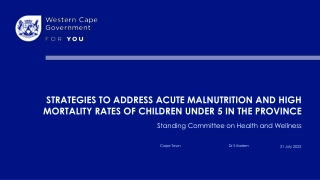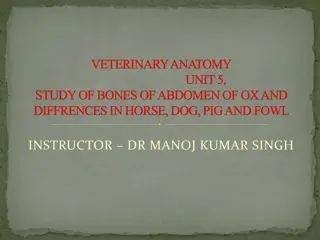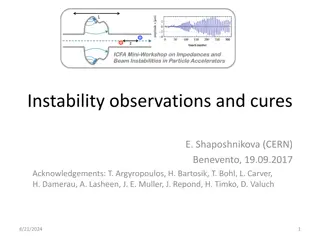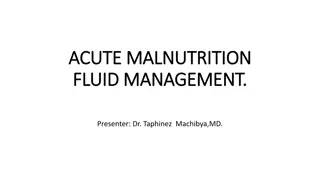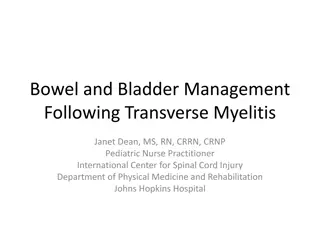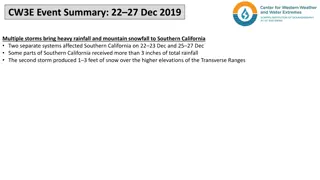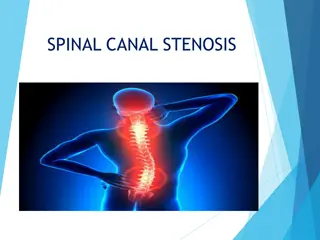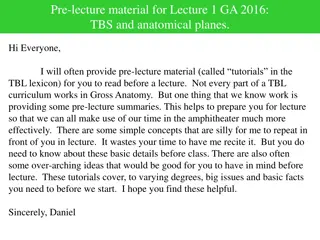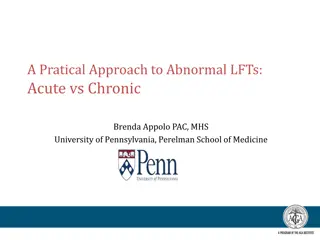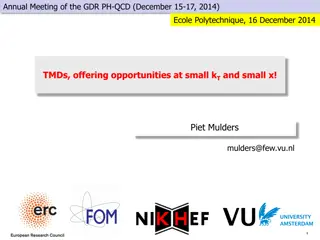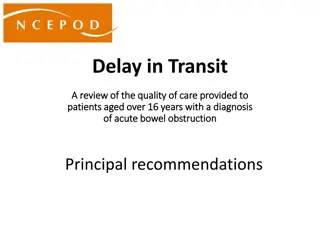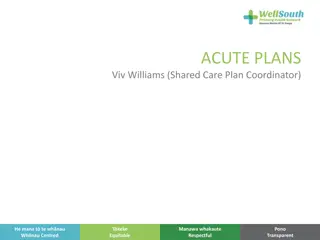Overview of Acute Transverse Myelopathy
Acute transverse myelopathy is a condition characterized by spinal cord damage resulting in impairment of motor and sensory functions. Common causes include traumatic spine injuries, tumors, multiple sclerosis, and vascular disorders. Symptoms may include sensory disturbances, motor disturbances like paraplegia or quadriplegia, and autonomic disturbances.
Download Presentation

Please find below an Image/Link to download the presentation.
The content on the website is provided AS IS for your information and personal use only. It may not be sold, licensed, or shared on other websites without obtaining consent from the author.If you encounter any issues during the download, it is possible that the publisher has removed the file from their server.
You are allowed to download the files provided on this website for personal or commercial use, subject to the condition that they are used lawfully. All files are the property of their respective owners.
The content on the website is provided AS IS for your information and personal use only. It may not be sold, licensed, or shared on other websites without obtaining consent from the author.
E N D
Presentation Transcript
CARDIOVASCULAR DISORDERS & HYPERTENSION 5th level students Dr.Essmat Mansour
GENERAL SYMPTOMATOLOGY OF CVS Chest pain Ask about the quality (stapping , heaviness, dull, sharp , crushing , pressure ) Location and radiation , precipitating and reliving factors ) Shortness of breath include 3 types : Exertional, means breathlessness on moderate exertion that relive by rest Paroxysmal nocturnal , means sudden dyspnea at night awakens patient with feeling of suffocation . Orthopnea , means shortness of breath when lying down
Palpitations It is a hearing of pounding , beat too fast it may indicate tachydysrhythmia Weakness & fatigue It is produced by low cardiac output Syncope Is a transient loss of consciousness due to a fall in cardiac output Near syncope Refers to lightheadedness , dizziness and temporary confusion .
PHYSICAL EXAMINATION V/S Heart rate in one full mint , note regularly Compare pulse deficit (the difference between apical and peripheral heart rate . Monitor blood pressure Take pressure in both arms and note the difference (5-10 mm hg )is normal but if it is more it indicates certain pathological condition
Assess for postural hypotension Orthostatic changes evident if blood pressure decrease by 15 mm Hg (systolic ) or 5 mm Hg diastolic and /or heart rate increases 15 beats with position changes . Skin and extremities : Diaphoresis o Warm /dry skin indicates adequate cardiac output o Cool, clammy skin indicates compensatory vasoconstriction due to low cardiac output
Cyanosis Cyanosis is bluish discoloration of the skin and mucous membrane , there are 2 types : a) Central cyanosis ; low oxygen saturation of arterial blood ,noted on tongue , buccal mucosa and lips b) Peripheral cyanosis : reduced blood flow through extremities due to vasoconstriction , noted on nose , ear lobes due to cold exposure or obstructive vascular diseases Jaundice Yellowish discoloration of sclera, eye lids , or skin may be a sign of rt.side heart failure
Nail beds (clubbing nails ) Is swollen nail beds and loss of normal angle is associated with congested heart diseases
Edema Is an abnormal accumulation of serous fluids in soft tissues o Locations of edema is influenced by gravity o Degree of pitting edema : a) 0 no edema b) 2mm mild edema c) 4 mm moderate edema d) 6mm moderately sever edema e) 8 mm severe edema
NECK VEIN DISTENDED VENOUS PULSATION CAN BE MORE EASILY SEEN THAN FELT
DIAGNOSTIC LAB TEST Enzymes When myocardial tissues is damaged ,certain cardiac enzymes are released into the blood stream as: Creatine kinase (CK) Lactic DeHydrogenase (LDH) ASprate aminoTransferase (AST, )or formerly (SGOT) Serum Glutamic Oxalic Transaminase but it is not indicative because it is related to skeletal, liver ,brain and kidney damage a) b) c)
RADIOLOGICAL EXAMINATION Chest X-ray shows heart size and position Myocardial imaging , with the use of radionuclide camera . Angiography , injection of contrast medium into vascular system to outline the heart and blood vessels ,useful for providing information regarding coronary anatomy , structural abnormalities Echocardiography(ultrasound cardiography )useful in providing information include deformities , pericardial effusion valve function . Doppler ultrasound , noninvasive method of evaluating peripheral venous patency , the task take 5-10 minte and no need for special preparation
HYPERTENSION Is a disease of vascular regulation in which the mechanisms that control arterial pressure within the normal range are altered . Pathophysiology and etiology : Primary hypertension , approximately 95% of patients with hypertension . When the diastolic pressure is 90 mm Hg or higher and other causes of hypertension are absent , the condition is called primary hypertension . An individual is considered hypertensive when the average of 3 or more BP readings taken at rest .
CAUSES OF ESSENTIAL / PRIMARY HYPERTENSION The exact cause is unknown , but there are several risk factors as : Increased cardiac output Excessive dietary sodium intake , sodium retention , insulin resistance iii. Familiar (genetics ) tendency i. ii. Elevation of systolic hypertension in the absence of elevated diastolic blood pressure is termed isolated hypertension and is treated in the same manner .
SECONDARY HYPERTENSION Occurs in approximately 5% of patients with hypertension secondary to other pathology ; Renal pathology ii. Stenosis of the aorta iii. Endocrinal disturbances iv. Medications as estrogen Consequence of hypertension : Prolonged hypertension damages blood vessels in the brain , eyes , heart and kidneys and increase the risk of stroke , angina , myocardial infarction , blindness and heart ,kidney failure . i.
PREVALENCE AND RISK FACTORS There are no symptoms , thus it is termed the silent killer . Increase in incidence is associated with the following risk factors : Age between 30 and 70 Race _African American Overweight , sleep apnea family history Smoking Sedentary life Diabetes mellitus
CLINICAL MANIFESTATIONS Usually asymptomatic May cause headache , dizziness, blurred vision when greatly elevated . Blood pressure readings as the next slide showed
DIAGNOSTIC EVALUATION OF HTN ECG to determine the effect of HTN on the heart muscle Chest x-ray may show cardiomegaly Protinuria , elevation of serum blood urea Decreased serum potassium
MANAGEMENT LIFE STYLE MODIFICATIONS Lose weight if body mass index is greater than or equal 27 Limit alcohol Get regular aerobic exercise equivalent to 30 to 45 min of walking most days Cut sodium intake to 2.4g or less /day Include daily allowance of potassium , calcium and magnesium in diet Stop smoking Reduced dietary saturated fat and cholesterol Consider reducing coffee intake (5 cups /day increased the BP) If despite modification of life style , the BP remains high over 3-6 months , drug therapy should be initiated .
DRUG THERAPY Diuretics , lowering BP by promoting urinary execration of water and sodium . Blockers beta adrenergic inhibitors that lower BP by slowing the heart rate and reducing cardiac output .
DRUG THERAPY -Receptor blockers that lower BP by dilating peripheral blood vessels and lowering peripheral vascular resistance Angiotensin converting enzyme (ACE ) inhibitors that lower BP by blocking the enzyme that converts angiotensin I to potent vasoconstrictor angiotensin II . These drugs also raise the level of bradykinin , a potent vasodilator .
DRUG THERAPY )CONTINUE The best management of hypertension is to use the fewest drugs at the lowest doses while encouraging the patient to maintain lifestyle changes After BP has been under control for at least a year , a slow progressive decline in drug therapy can be attempt If the desired BP is still not achieved with the addition of a second or third drug
NURSING CARE OF HTN PATIENTS Assessment : Past , present and family history Previous episodes of high blood pressure Dietary habits and salt intake Cigarette smoking Episodes of headache , weakness , muscle cramp , tingling , palpitations , sweating & visual disturbance . Medications that elevate BP as oral contraceptive , NSAID,nasal decongestants , appetite suppressants
PHYSICAL EXAMINATION Auscultate heart rate and palpate peripheral pulses , determine respiration Measuring BP Nursing Diagnosis : Knowledge deficit R/T treatment regiment Ineffective management R/T therapeutic regimen
NURSING INTERVENTIONS Explain the meaning of high BP risk factors , effect on CVS , renal ,cerebral Stress that there can never be total cure , only control of the disease will achieved Stress that there is no relation between the symptoms and the disease
NURSING INTERVENTIONS(CONTINUE Explain the pharmacologic control of hypertension Note that dosage are individualized Warn the patient on vasodilating therapy to use caution in certain circumstances as ; Hot bath , hot weather , consumption of alcohol, and fibril disease o Warn the patient that BP is often decreased when circulating blood volume is reduced as in diarrhea ,vomiting , dehydration or hemorrhage so close monitor of BP is required


